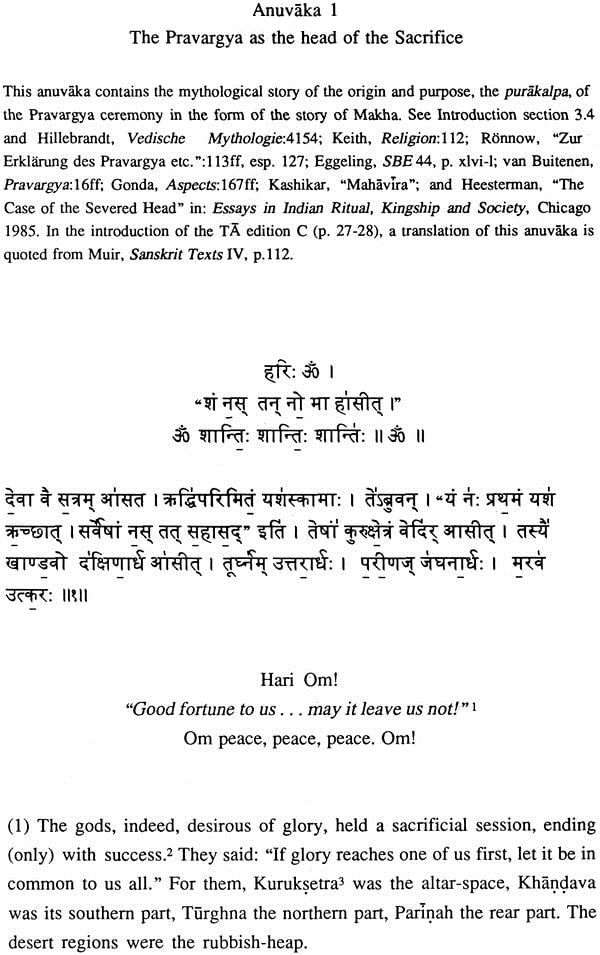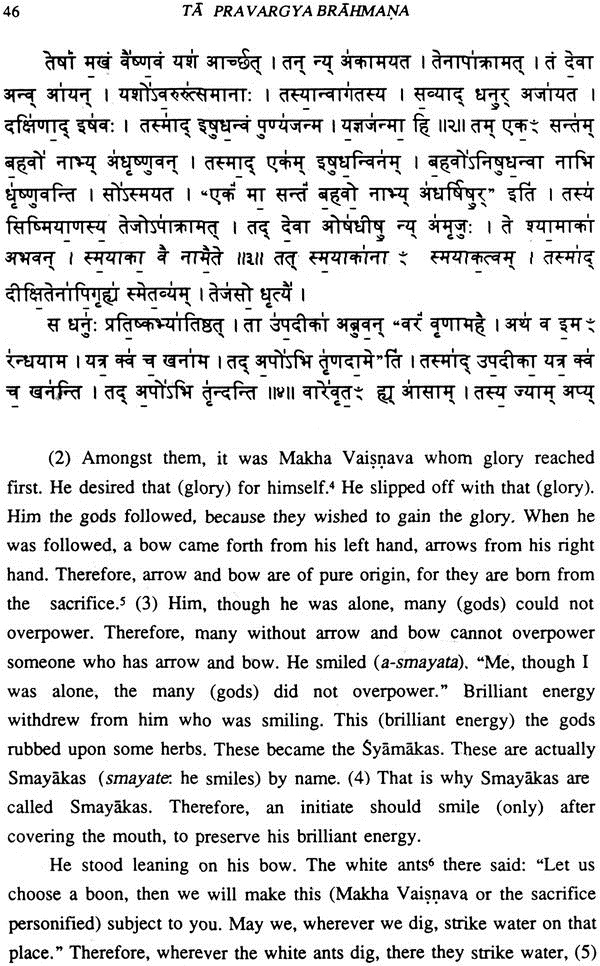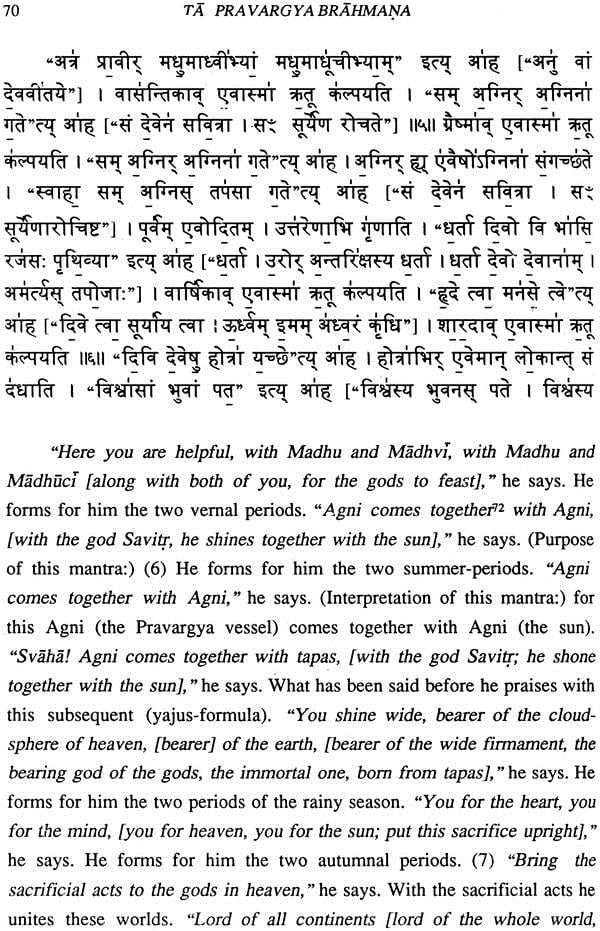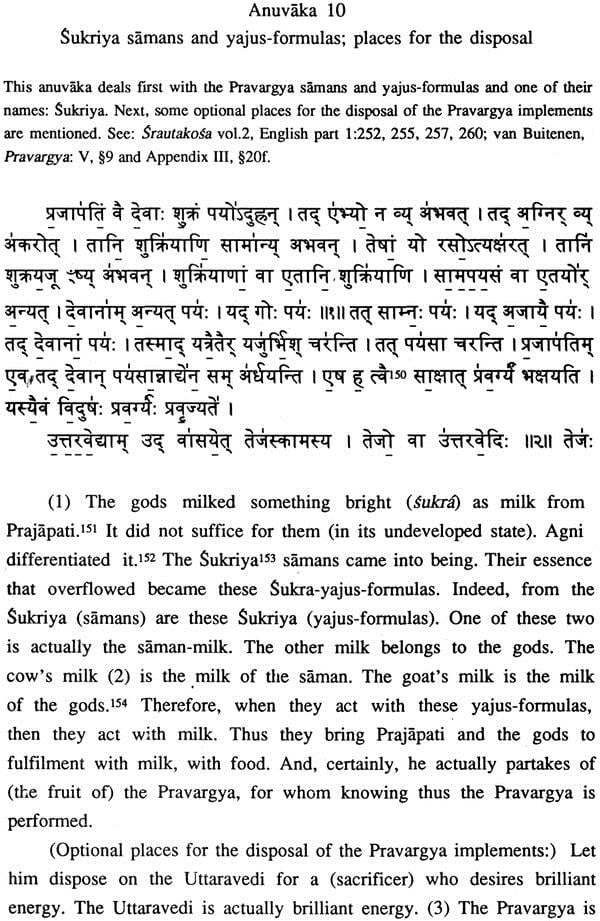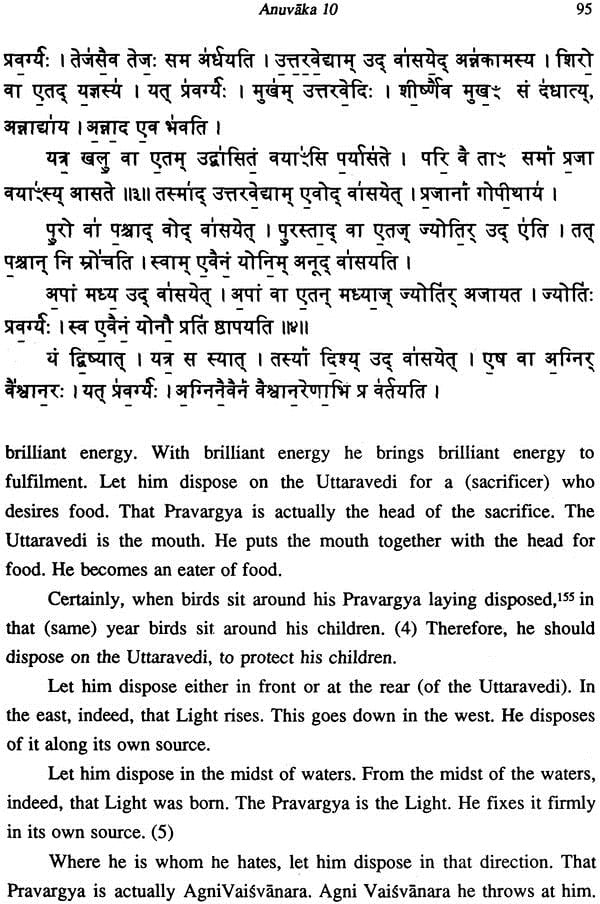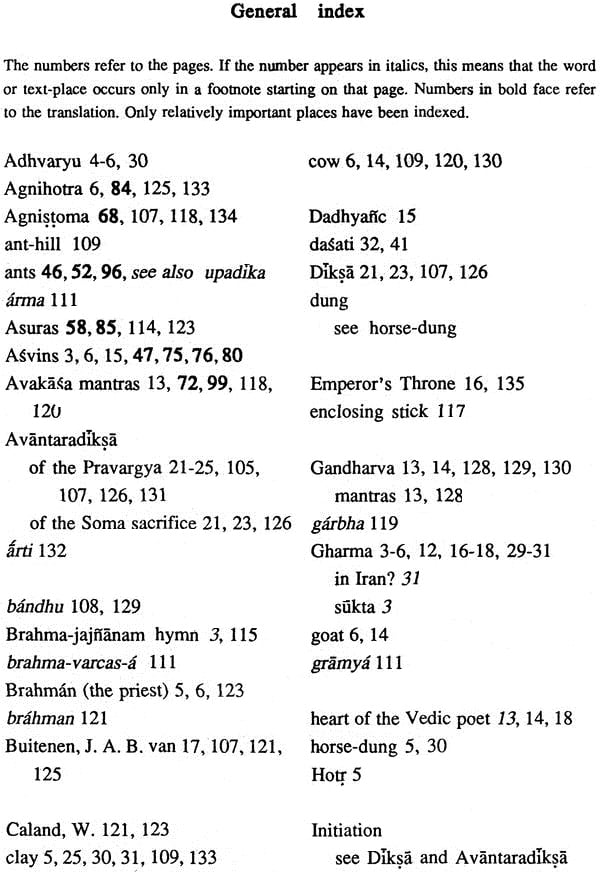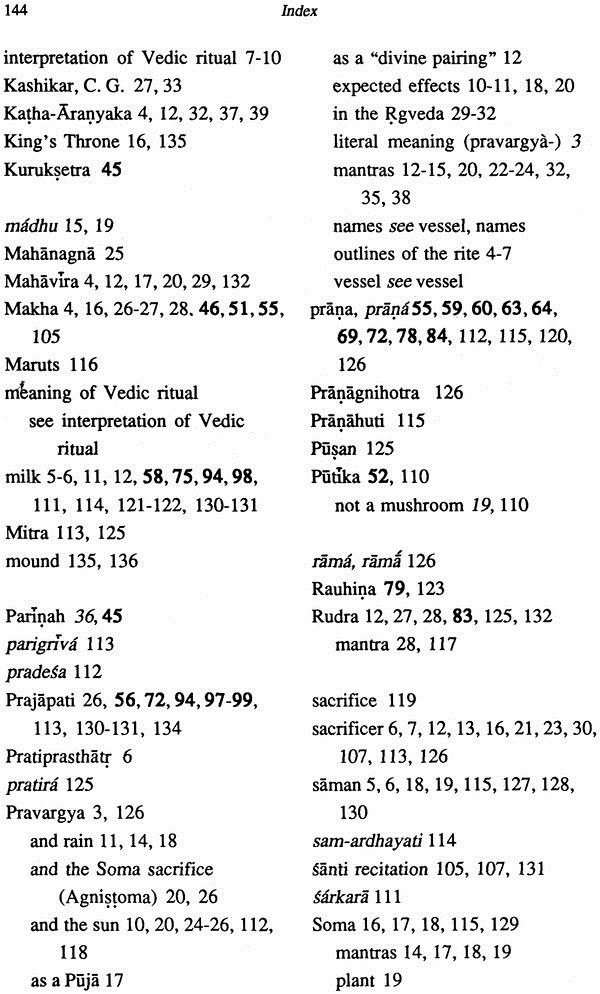
THE PRAVARGYA BRAHMANA OF THE TAITTIRIYA ARANYAKA (an ancient commentary on the Pravargya ritual)
Book Specification
| Item Code: | NAB391 |
| Author: | Ed. by. Jan E. M. Houben |
| Publisher: | MOTILAL BANARSIDASS PUBLISHERS PVT. LTD. |
| Language: | English |
| Edition: | 1991 |
| ISBN: | 9788120808683 |
| Pages: | 161 |
| Cover: | Hardcover |
| Other Details | 8.8" X 5.8" |
Book Description
About the Book:
Prapathaka 5 of the Taittiriya Aranyaka in the Andhra recension (= prapathaka 8 in the Dravida recension) is an ancient commentary on the Pravargya ritual. This commentary, the 'Pravargya Brahmana', is here translated and annotated. The Introduction contains a study of the Pravargya ritual, which is "One of the few rituals that has been explicitly referred to in the Rgveda (usually under the name "Gharma"). The abstract and spiritual nature of what is probably the main purpose of the ritual - the participants should acquire the lustre of the sun - the simple means by which it can be performed and the way the main implement, the pot which is heated red-hot, is worshipped, give it a special place in the vast assortment of Vedic rites.
The Sanskrit text of the Pravargya Brahmana of the Taittiriyakas has been given along with the translation. The present work was prepared under the guidance of Professor Dr. H.W. Bodewitz (Utrecht), and is an elaboration of an essay written by the author in partial fulfilment of the requirements for the degree of 'doctorandus' at the University of Utrecht, 1987.
About the Author:
Jan E.M. Houben was born in a village in the southern part of the Netherlands in 1960. Between 1978 and 1987 he studied Psychology, Linguistics, and classical and Vedic Sanskrit at the State University, Utrecht. At present he is a research worker at this University, at the Institute of Oriental Languages and Cultures.
The Taittiriya Aranyaka contains several elements from a later origin than the Taittiriya Brahmana and Samhita. The recognition of this by scholars like A. Weber and A. B. Keith, may have been the reason for their relative neglect of this part of the Taittiriya tradition. However, the mantras and Brahmana of the Pravargya ritual have found their place in the Aranyaka probably not because they originated later, but because of the special character of the Pravargya ritual. The Pravargya is one of the few rituals that has been explicitly referred to in the Rgveda (usually under the name “Gharma”). The abstract and spiritual nature of what is probably the main purpose of the ritual - the participants should acquire the lustre of the sun - the simple means by which it can be performed and the way the main implement, the pot which is heated red-hot, is worshipped, give it a special place in the vast assortment of Vedic rites.
For a complete description of the Pravargya according to the Srauta Sutras, the reader is referred to van Buitenen’s The Pravargya (Poona, 1968) and the Srautakosa. The present book gives a translation and discussion of the Pravargya Brahmana of the Taittiriya tradition. It is, depending on the recension, either the fifth or the eighth chapter of the Taittiriya Aranyaka. The text discusses the use of the Pravargya mantras and abounds in Brahmanical explanations of the mantras and acts. It follows the ritual in an older, slightly different version than the Srauta Sutras. The translation and introduction intend to make the text accessible to students of comparative cultural history, to Sanskrit students who are not specialists in the field of Vedic ritual (the Sanskrit text has been given with the translation), and to others who might be interested in the subject. Scholarly problems connected with the text and its subject are discussed in notes at the end.
My study at the State University Utrecht, under my Sanskrit teachers, dr. L. van Daalen and dr. T. Goudriaan, and especially under my teacher in Vedic Sanskrit, prof. dr. H. Bodewitz, resulted in the “doctoraalscriptie” (1987) on which the present book is based. To their teaching and continuing inspiration I owe a lot. Without the latter’s patience in discussing and criticizing, on the basis of his thorough knowledge of the intricacies of the Vedic ritual, earlier drafts of this work, I would have given up halfway. I am thankful to Dr. G. Kreyenbroek, who helped me find the information I needed about Old Iranian rituals. In an indirect way prof. em. J. Gonda contributed to this book, not only through his highly valuable works in the field of Vedic studies, but also because all of my Sanskrit teachers were former students of his. While I alone am responsible for the shortcomings which this book no doubt still has in spite of all efforts to avoid them, it is my pleasant duty to express my thanks to these teachers and also to the following persons. I thank mr. A. J. A. C. Nooteboom, mr. D. O’Brien (London) and ms. L. N. Vallaster (Vancouver) for their advice concerning style and diction, and mr. S. Chu (Vancouver) for his help in drawing the plan of the place of sacrifice (Appendix). In Vancouver I incurred moreover the debt of gratitude to dr. G. Sparham, prof. dr. A. Aklujkar and prof. dr. K. Bryant, for their help and advice concerning the computerized processing of this text. Both for the roman and for the Devanagari script I used prof. Bryants’ fonts. I am also thankful to mrs. H. Zweerus of the Computer centre of the State University Utrecht, who helped me solve some technical problems in the final stages of the preparation of the manuscript.
Finally, thanks are due to the publishers of Motilal Banarsidass, for accepting this work for publication.
PREFACE
ABBREVIATIONS
Part I
- INTRODUCTION
-
- The Pravargya Ritual
- Short Description of the Rite
- Interpretation of the Pravargya
- 3.1. The Pravargya and the Sun
3.2. The Pravargya and Soma
3.3. The Pravargya and the Intermediate Initiation
3.4. The Pravargya Myth - The Age of the Pravargya Ritual
- Taittiriya Aranyaka 5 and its relation to the Brahmana and Samhita
- Taittiriya Aranyaka 5 and its relation to other texts
- About the Text and Translation
Part II
- TEXT AND TRANSLATION
Anuvaka 1: The Pravargya as the head of the Sacrifice
Anuvaka 2: Collection of the materials for the Pravargya Ritual
Anuvaka 3: The preparation of the Pravargya vessel
Anuvaka 4: Putting up and heating the Pravargya vessel
Anuvaka 5: Praising the installed Pravargya vessel
Anuvaka 6: Gazing at the heated Pravargya vessel
Anuvaka 7: Milking the cow and the goat
Anuvaka 8: The offering to the Asvins
Anuvaka 9: The disposal of the Pravargya implements
Anuvaka 10: Sukriya samans and yajus-formulas; places for disposal
Anuvaka 11: The different names of the Pravargya Ritual
Anuvaka 12: Metamorphoses of the Pravargya
NOTES TO THE TEXT AND TRANSLATION
Appendix 1: The Place of Sacrifice
Appendix 2: Concordance of the three editions
General index
Index of textplaces
